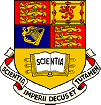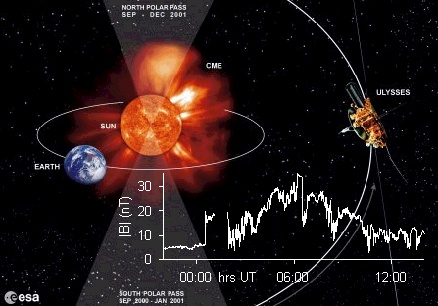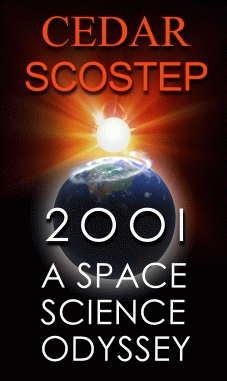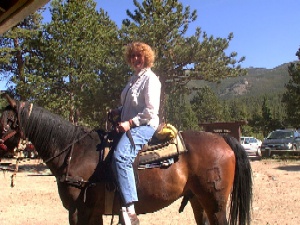
 |
|
News Page |

July 2001 |
This month's news stories:Ulysses strongest magnetic fieldReport on SCOSTEP meetings |
 Ulysses detects its strongest magnetic field in 10 years
Ulysses detects its strongest magnetic field in 10 yearsOn 10th May 2001 the Imperial College magnetometer onboard the Ulysses spacecraft measured, at 35 nT, the strongest interplanetary magnetic field it has encountered during its 10 years plus mission so far. This is about seven times the typical interplanetary field strength in the vicinity of the Earth. The cause of this extreme event was quickly identified as a coronal mass ejection (CME) which had left the Sun three days earlier on 7th May.
Ulysses, launched on 6th October 1990, was propelled into a polar orbit of the Sun by a gravitational swingby of Jupiter in 1992 to become the first spacecraft ever to explore the heliosphere over the full range of latitudes away from the ecliptic plane. The orbit has a 6 year period, thus the first six years of the mission gave a characterisation of the helisophere under the relatively simple conditions of solar minimum activity. Now Ulysses is making its second orbit of the Sun while the Sun is at its most active during solar maximum. As shown in the diagram on the right, Ulysses was close to its perihelion at 1.3 AU from the Sun and at 4°S latitude at the time of the 10th May event. During this phase of its orbit Ulysses makes a fast latitude scan from the south polar regions of the heliopshere to the north polar regions in less than a year.
CMEs are often spectacular eruptions of material from the solar atmosphere, particularly common during solar maximum, which propagate outwards into interplanetary space. The image of the 7th May CME shown in the picture above was captured by the LASCO coronagraph instrument on the SOHO spacecraft as it erupted from the west limb of the Sun (the right side as seen from the Earth). Spectacular movies of the event can be downloaded from the LASCO website from the C2 coronagraph and C3 coronagraph. The westerly direction meant that the CME was not heading towards the Earth but, as shown schematically in the picture, this was the perfect direction for the event, travelling at about 900 km/s, to pass over Ulysses on 10th May. Superimposed on the picture is a trace of the magnetic field strength recorded by Ulysses as the event arrived. The first signature was a shock wave driven ahead of the CME which arrived at 0036 hrs causing an instantaneous increase in the field strength. The field then continued to increase to reach its maximum of 35 nT just after 0600 hrs, to be immediately followed by a region of very dense plasma, at about 100 particles per cubic centimetre also the highest density recorded by Ulysses. Such a high density region may be the remnant of a solar prominence, a structure which would previously have been held stable above the Sun's surface by loops of magnetic field prior to the eruption of the CME.
Quoted in ESA's Science News, Prof André Balogh, Principal Investigator of the magnetometer team at Imperial College, said "We now want to follow the way the different magnetic loops raced out from the Sun so that we can understand the complexity of this CME. Looking at the SOHO images and our magnetic field data, we can only admire its complexity, which was beyond anything you will read about in a text book."
Bob Forsyth 2nd July 2001
 Jo Haigh reports on SCOSTEP meetings in Colorado...
Jo Haigh reports on SCOSTEP meetings in Colorado...Jo Haigh recently spent a week in Longmont, Colorado, USA attending two meetings both under the auspices of the Scientific Committee on Solar-Terrestrial Physics (SCOSTEP). The first meeting (13-16 June), organised by the International Solar Cycle Studies group, was entitled "Solar Variability, climate and space weather" and included sessions on solar irradiance, solar energetic particles and CMEs, physical interpretation of solar variability and sun-earth connections. All talks were from invited speakers and plenty of time was allocated for working groups and poster displays. Jo gave a talk on "Modelling studies of the response of the lower atmosphere to solar variability" and learnt a lot about the sun from the interdisciplinary sessions. Particularly fascinating were the discussions on what is known about the internal variability of the sun and how this affects outgoing irradiance. There appears to be some controversy concerning whether irradiance variability is due to the compensating effects of sunspots and faculae or to changes in internal structure causing variations in the temperature of the photosphere.
The second meeting was the SCOSTEP 10th Quadrennial Solar-Terrestrial Physics Symposium (18-22 June) which was held jointly with the 2001 CEDAR (Coupling, energetics and dynamics of the atmospheric region) workshop and was attended by about 200 delegates. The joint meeting was entitled "2001 A space science odyssey" and the opening plenary started predictably with a loud rendition of the appropriate section of Strauss' Also Sprach Zarathustra which left Marv Geller (who was waiting to open the meeting) twitching his moustache in amusement and wishing he could always be introduced with such pizzazz. The meeting mainly ran in two parallel sessions apart from the hour-long tutorial lectures of which there was one each half-day. The flavour can be gauged from these tutorials which were
[Videos of the tutorial lectures are available from the SCOSTEP office]
 In the session entitled "long-term variability of earth's climate, including solar influences" other particularly interesting talks were given by Murry Salby, on the involvement of solar variability in long-term changes of the stratosphere, and Bill Randel on detecting change in the
lower middle atmosphere.
In the session entitled "long-term variability of earth's climate, including solar influences" other particularly interesting talks were given by Murry Salby, on the involvement of solar variability in long-term changes of the stratosphere, and Bill Randel on detecting change in the
lower middle atmosphere.
Longmont is a place which probably doesn't get too many tourists and the conference centre was situated within an unlovely area of suburban sprawl, although it was just possible to get a glimpse of the Rockies from the west side of the shopping mall. At the weekend Jo escaped from Longmont and was generously entertained by a friend from Boulder - including star-gazing from within a hot-tub and a two-hour trek within the Rocky Mountain National Park on a (fortunately very docile) horse. It all seemed very remote from IC and exam-marking.
Jo Haigh 26th June 2001
View last month's news, older news or return to Space and Atmospheric Physics home page